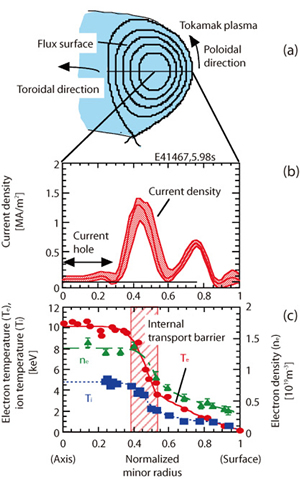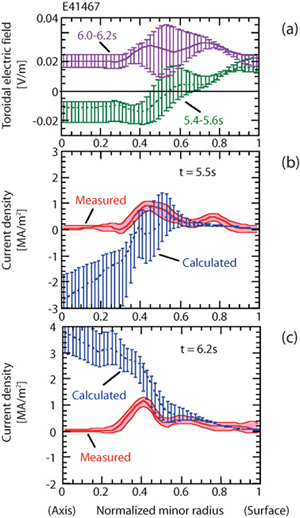
Fig.3-7 Current hole in tokamak plasma

Fig.3-8 Application of electric field to a current hole
Electric conductivity is one of fundamental material properties; materials may be a good conductor, an insulator, or a semiconductor. A plasma, which consists of ions and electrons, is a good conductor since an electric current is easily generated by motion of ions and electrons. The higher the electron temperature, the more easily the current flows. The conductivity of plasma with 13 million K electron temperature is close to copper.
We observed stable plasma sustained for several seconds in the "JT-60" tokamak with nearly zero magnetic field in the poloidal direction and hence nearly zero toroidal current in a substantial central region ("current hole") (Figs.3-7 (a) and (b)). A very-high-temperature plasma with an electron temperature of 10 keV (1.16 billion K) is confined stably in a current hole (Fig.3-7 (c)).
It was not known why a current hole is maintained in a very-high-temperature plasma with high conductivity. Is it because the current driving source such as an electric field becomes zero, or because some mechanism opposes the current driving force and keeps the current around zero? To find the answer, the response of a current hole to change in the driving source has been studied, precisely measuring the inductive electric field in the plasma. When the inductive field was changed by starting and stopping current drive and electron heating with electron cyclotron waves outside the current hole, a finite inductive electric field was generated in the central portion of the plasma (Fig.3-8 (a)). A large current is predicted, based on the theoretical value of electric conductivity of plasma ("Calculated" in Figs.3-8 (b) and (c)), but the measured current remained close to zero ("Measured"). Furthermore, current drive with electron cyclotron waves also failed to generate the current and destroy the current hole.
From these results, it has been shown experimentally for the first time that some mechanism works to keep the current density at zero level once it reaches that level in the central region. An insulator appears to be created in the central region of tokamak plasma, which generally has high conductivity. This observation reveals an anomaly of current profiles in the tokamak plasma, namely, in certain cases the profile is determined as a whole structure, not by driving force alone as has been thought. This is a new and remarkable phenomenon of structure formation in high-temperature plasma.